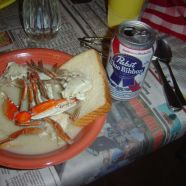Grandmother’s Cooking/Cuisine de Grand-mère
I don’t think of myself as sentimental or nostalgic, but having said that, I confess that almost every day I look back to inform my work. Now more than ever I find myself trying to bring the good but simple food of eastern North Carolina to the diners at Crook’s Corner. I grew up in a time when large families were still the norm. Like as not, these families were run by matriarchs. Ours on my mother’s side of the family was my great-grandmother Inez. She was a fantastic cook and hardly a day passes when I don’t think back on something she had cooked.
I paid a lot of attention to cooking as a child. This was way before it ever occurred to me to be a chef. (I was sometimes called upon to assist. For instance, if I produced four cups of wild blackberries or perfect pecan halves, there would be a pie.) At my grandmother’s table, food was a serious topic. Endless discussions of country butter versus store bought; arguments over seasoning; backhanded compliments about skills. Without even realizing it, I was learning a point of view that shapes me as a professional chef. Good food. No nonsense.
Hard crab stew is one of those favorites that I had not brought to the restaurant because it is so messy to eat. It’s a summer stew, eaten outdoors on tables covered with newspapers. It has rituals. We probably only had it twice a summer. Once in grandmother’s garden and once during the week when we took a house at the beach. In those days, we caught our own crabs, so it could be quite a production for that reason alone. All you need is a chicken neck on a string and a scoop net. It is a stew that is eaten with the hands as much as with a spoon. There is a slice of white bread in the bottom of every bowl. Don’t make fun. I served it to a group of friends at the Outer Banks last weekend and their bowls were clean.
I have finally begun serving a more refined, less messy version of hard crab stew at Crook’s Corner and public events. Below, however is the original. Nut crackers help you get to the meat. Use the claw shells to dig it out. Most people only have patience enough for a crab or two, but it’s the broth that counts—along with the slice of white bread.
RECIPE FOR HARD CRAB STEW
Serves a crowd
½ pound sidemeat or fatback
2 medium onions, peeled and cut into large dice
2 dozen hard crabs, cleaned and halved
½ teaspoon crushed red pepper flakes
4 bay leaves
1 teaspoon thyme
6 baking sized potatoes, peeled and cut into eighths
¾ cups all-purpose corn meal, stirred into two cups of cold water
Salt and pepper to taste
Sliced grocery store white bread
Render the sidemeat in a large stock pot. Do this slowly, as it has a low smoking point and you want to extract as much fat as possible before it gets too brown. It will resemble crisp bacon in color when ready. Add the onions and sauté until soft but not brown. Add the crabs and cover with cold water. Add the red pepper, bay and thyme. Bring to a boil, then turn back to a simmer. Cook for half an hour, and then add the potatoes. Cook until they are well done, fifteen to twenty minutes more. Turn up the heat a little (but you don’t want a hard boil) a stir in the corn meal and water. This will be a little difficult because of the crabs. You need to mix this in thoroughly. Bring back to a simmer until the stew begins to thicken. Taste for salt and pepper. Sometimes the sidemeat will be saltier than other times.
To serve, put a slice or two of bread in the bottom of large soup bowls and ladle the stew, crabs and all on top. Claw crackers would be handy. We used to get yelled at for cracking the claws with our teeth.







